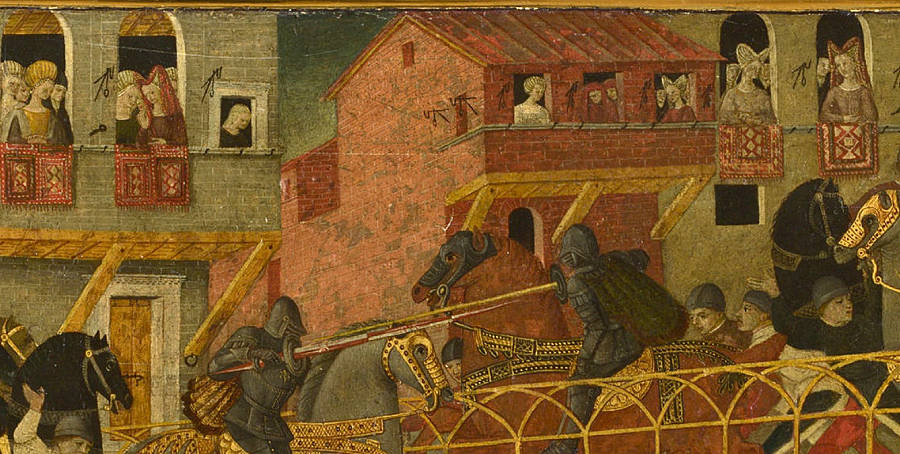
Home Page Discussion
The Salon du Tapis d'Orient is a moderated discussion group in the manner of the 19th century salon devoted to oriental rugs and textiles and all aspects of their appreciation. Please include your full name and e-mail address in your posting.
Rugs and Old Masters: Part 2 - Geometric Rugs in Early Renaissance
(14th and 15th Century) Paintings.
by Pierre Galafassi
Animal rugs were sometimes used as studio props for
early Renaissance paintings (14th and 15th century) but were not the
main type of rug at the time. Most carpets featured in
paintings of the period have purely geometric field motifs, which are
often unfamiliar to us and even puzzle the very few scholars who have
studied them. In many cases there is no extant rug featuring
these patterns. It is generally agreed that these rugs were
mostly woven in the Islamic world, in the large crescent from Anatolia
and Egypt to Maghreb and Al-Andalus (southern Spain).
However, scholars are rarely more specific than that.
I have made a feeble attempt at dividing these rugs based on their motifs.
A first group
are very small rugs featured in a fairly large number of early
paintings, mainly of the schools of Florence, Siena, Venice and
Ferrara, often depicted as decorations for windowsills and gondolas
during festivals (1). John Mills (2) thinks that their “geometric
designs look like highly simplified versions of Turkish rugs of the
second half of the (15th) century. Whether they were in fact early
versions of these or were locally made in imitation of them cannot be
certainly decided, but the latter does seem the more likely”.
As
a possible location for the workshops, a few southern Italian cities,
like Lucera (Puglia region) have been tentatively mentioned by some
sources, mainly owing to the fact that part of their population was
Muslims expelled from Sicily by Frederik II Hohenstaufen. Mills’ theory
of Italian copies is credible of course, but one could just as well
suspect Muslim populations of Sicily, Spain (as suggested by Giovanni
Curatola (3)) or Anatolia, (Walter. B. Denny (4)), to have woven them.

FIG 28
A. di Giovanni 1440-1460.
Cassone ( marriage chest) panel with scenes of tournament.
National Gallery London

FIG 29
A. Baldovinetti.Madonna and Child.
Uffizi. Florence.
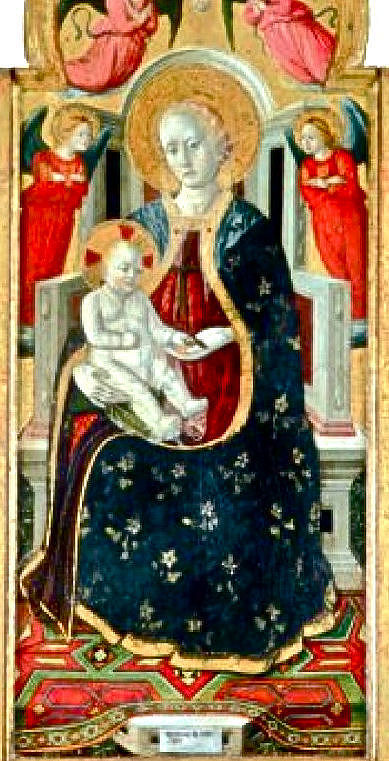
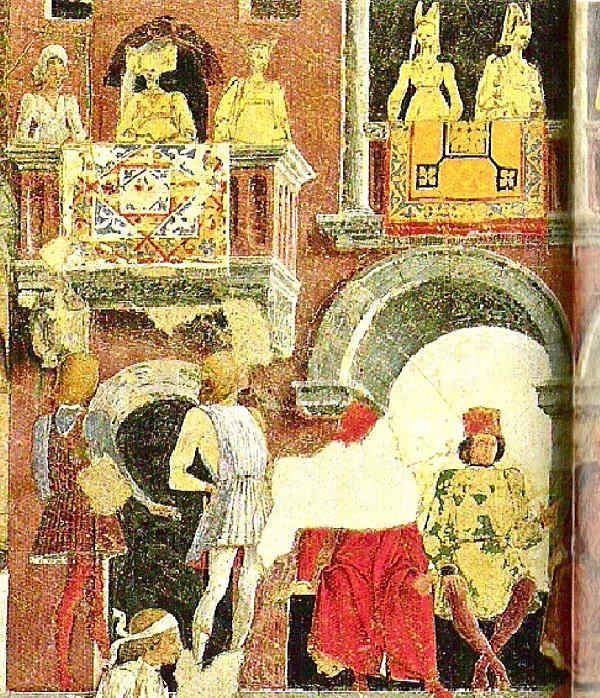
FIG 31
G. del Cossa. 1476-1484.
Allegory of April, detail.
Palazzo Schifanoia. Ferrara.
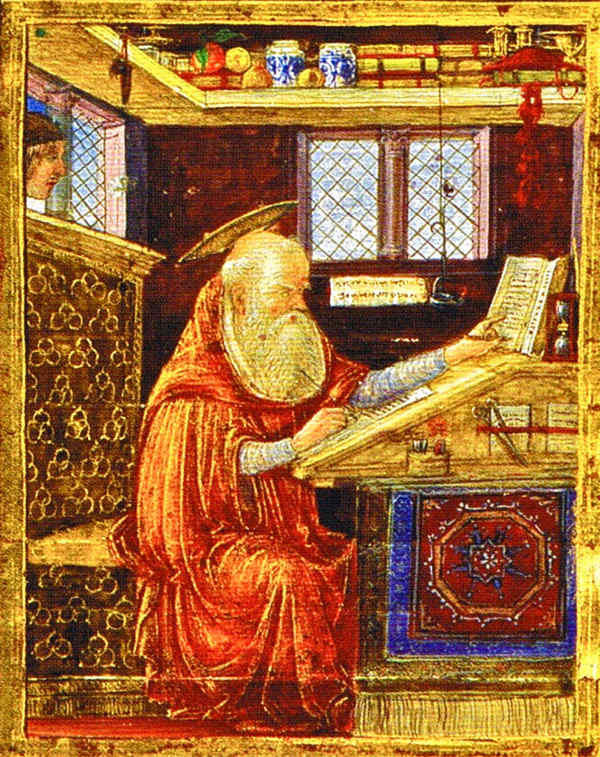
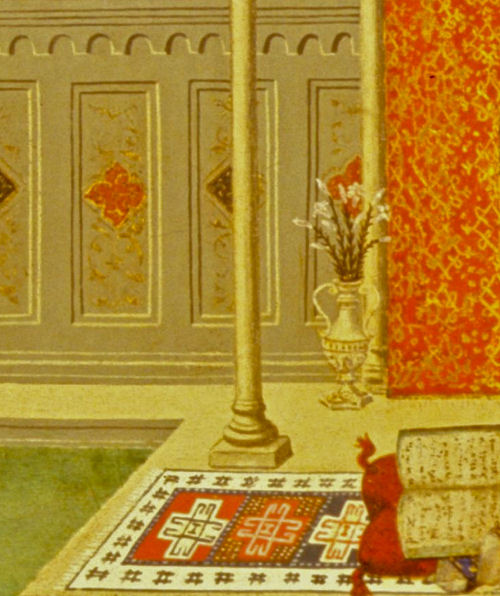
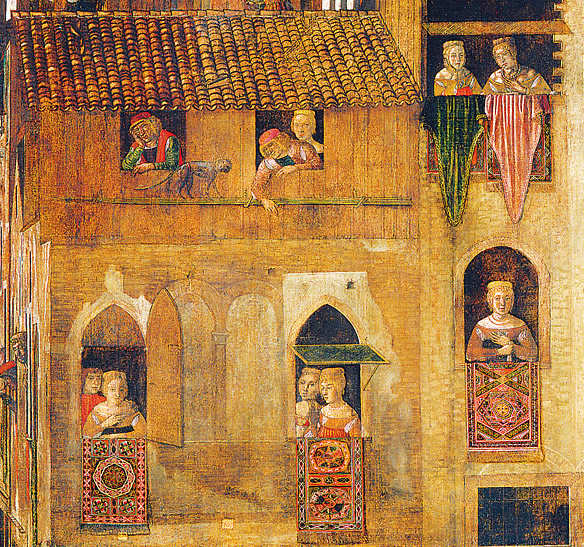
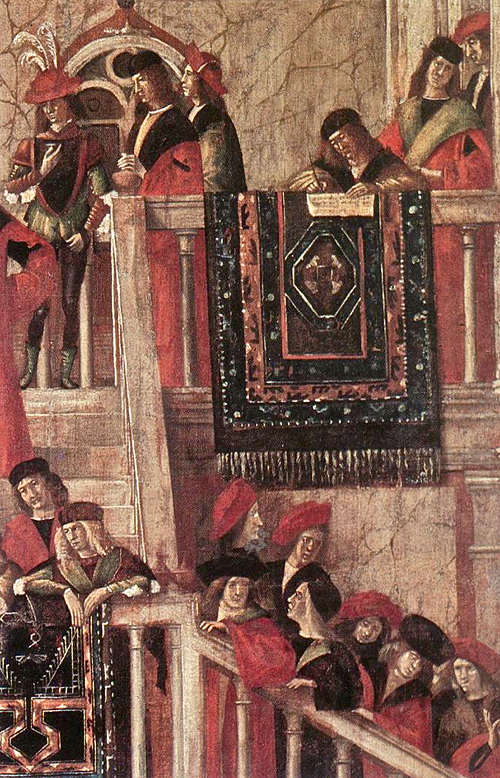
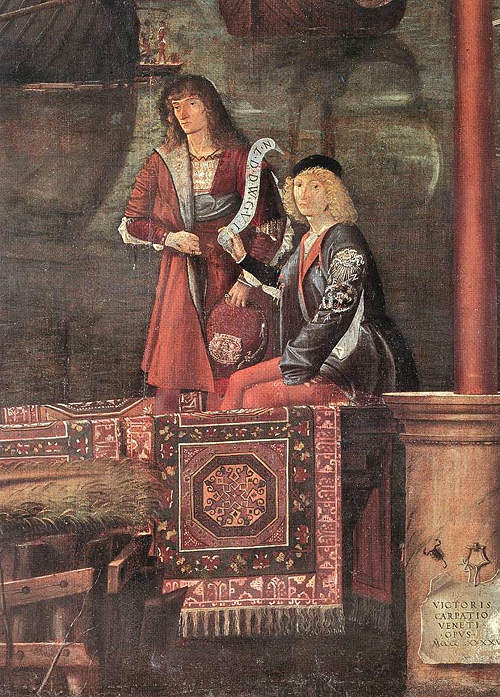
FIG 35 & FIG 36
V. Carpaccio. 1495.
Two details from the «Cycle of St Ursula, the departure of the pilgrims»
Accademia. Venice.
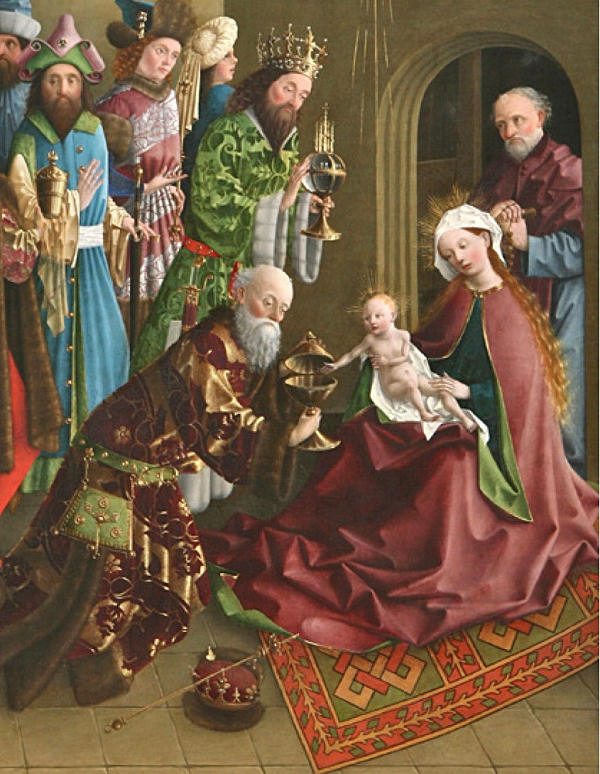
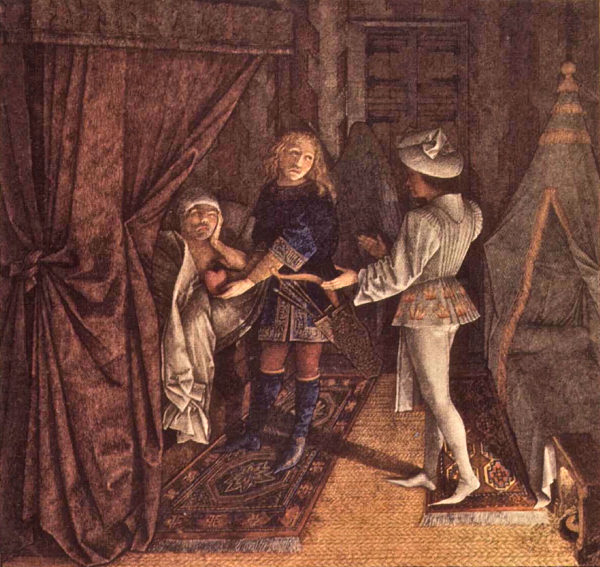
A
second group of rugs features geometrical patterns which, contrary to
most of those shown above, do not strike me as being particularly
“Turkish”. Their inspiration could just as well be European, Armenian
or Byzantine, for example. Onno Ydema (5) states that the undulating
“curvilinear stem with trefoil leaves (in the border) is almost
certainly derived from Western Gothic ornament”. The rugs are evidently
more densely knotted than the previous group, feature a normal border
and come in various sizes similar to those in later classical rugs.
About ten different rugs of this type can be seen in J. van Eyck’s, G.
David’s and Petrus Christus’ paintings. The strong similarities
of the motifs make a common origin very likely. To my limited
knowledge, no rug with such motifs is extant; thus, we have little
reason to expect that a structural analysis could give us clues to
their real origin.

FIG 39
J. van Eyck. 1436.
The Lucca Madonna.
Frankfurt.


A
third group of early paintings features rugs that can be clearly linked
to classical Anatolian patterns which were successfully copied and
expanded over the next few centuries. Especially so-called “small
pattern Holbein”, “large pattern Holbein”, “Para-Mamluk”, “Bellini” and
“Ghirlandaio” rugs. Many were used as studio props in paintings, and
even a few 15th century rugs are extant.
Four of the
oldest representations of “small pattern Holbein rugs” are found in
paintings by A. Mantegna, B. Baró, S. Botticelli and T. del Trombetto.
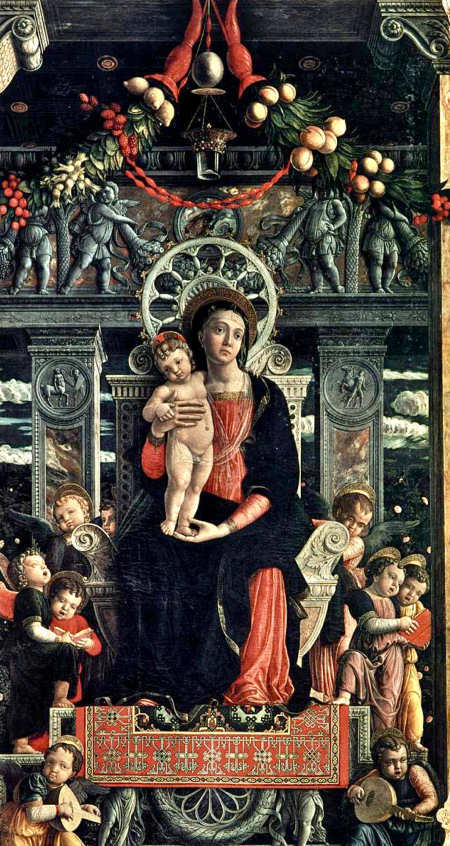

FIG 43
A. Mantegna. 1457-1459.
Virgin and Child. Detail.
San Zeno altarpiece. Verona
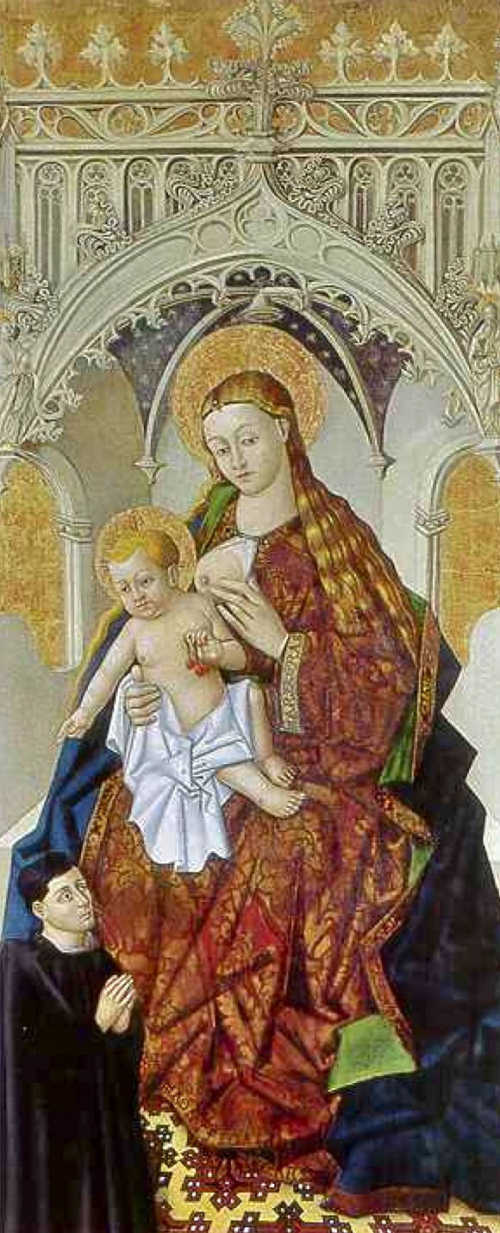
FIG 44
B. Baró 1450-1470
Virgen de la leche.
Ademuz. Spain.
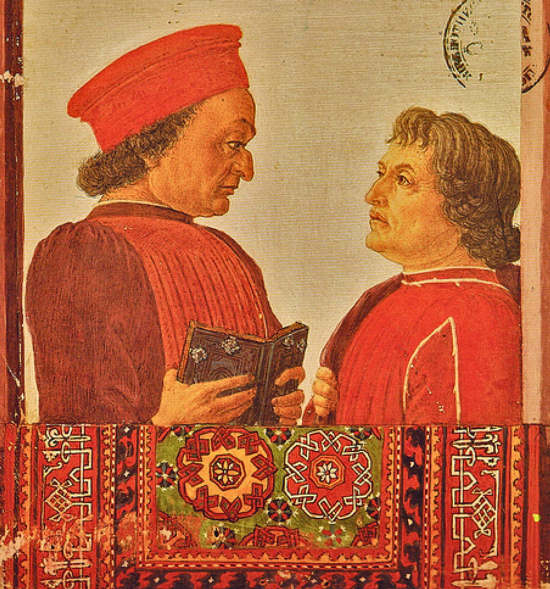
FIG 45
S. Botticelli. 1460.
F. de Montefeltre and Landino.
Vatican.


FIG 46 and FIG 47
Anatolian
rugs with «small Holbein» pattern. 15th
century.
In «Anatolian Carpets», W. B Denny. (FIG 46)
& in «Vakiflar Museum. Teppiche», B. Balpinar & U. Hirsch (FIG 47)
FIG 48 shows, arguably, the first representation of a Ghirlandaio pattern:
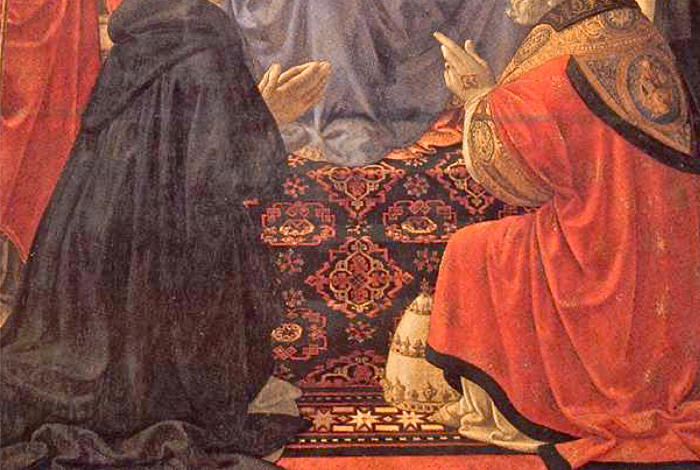
The first “para-mamluk” rugs were probably painted by F. Foppa and by Giovanni da Udine.
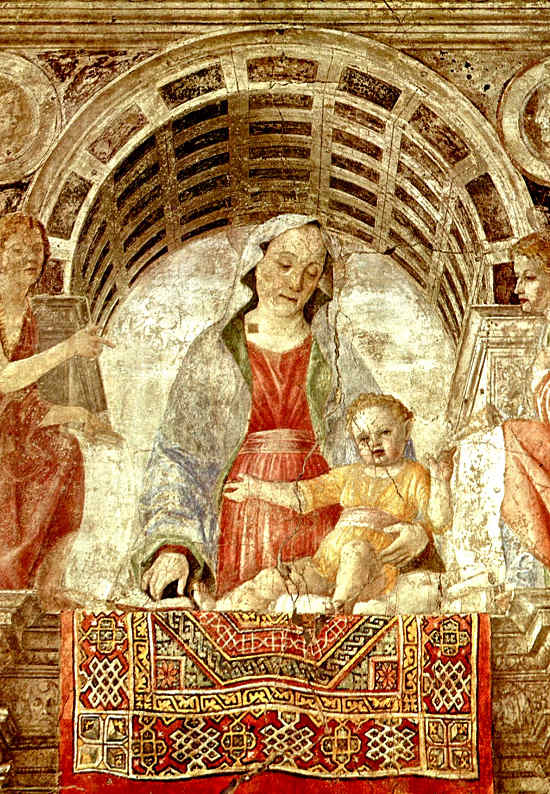
FIG 49
V. Foppa. 1485.
Virgin and Child. Detail.
Brera. Milan

The eponymous ancestor of the famous “Bellini” rug of the MIK in
Berlin (FIG 52) appears under the throne of the Virgin in a 1470
painting (FIG 51).
There are few extant “sober Bellini rugs”, none
with this border (6), but the single- and double “keyhole” (or
“re-entrant”) pattern remained a favorite of Turkish weavers for
another several centuries (for example, FIG 53).
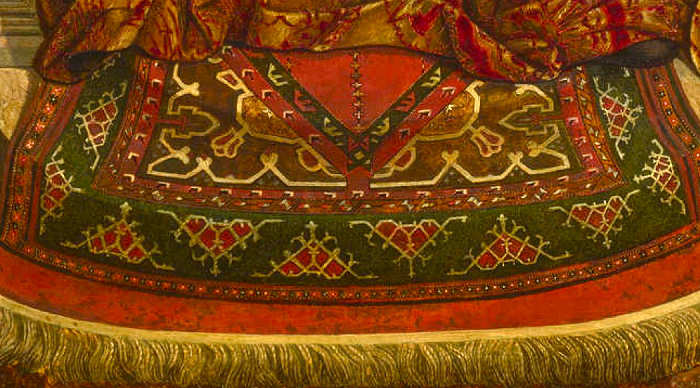
FIG 51
Gentile Bellini 1470.
Virgin and Child.
National Gallery, London
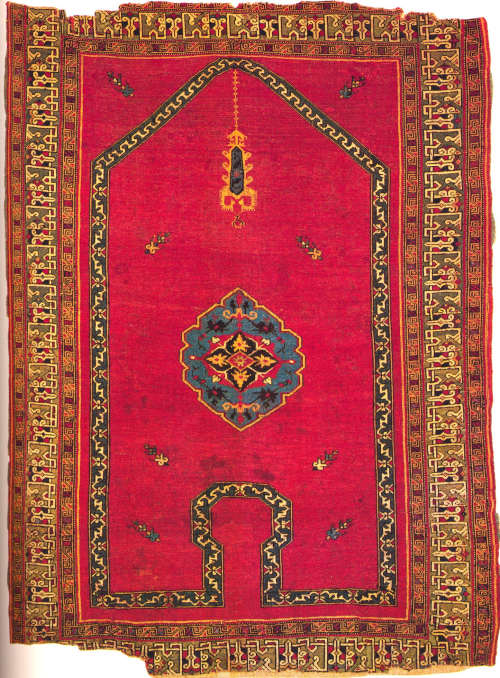
FIG 52
Ushak prayer rug with «Bellini» pattern.
16th century
Museum für Islamische Kunst. Berlin.
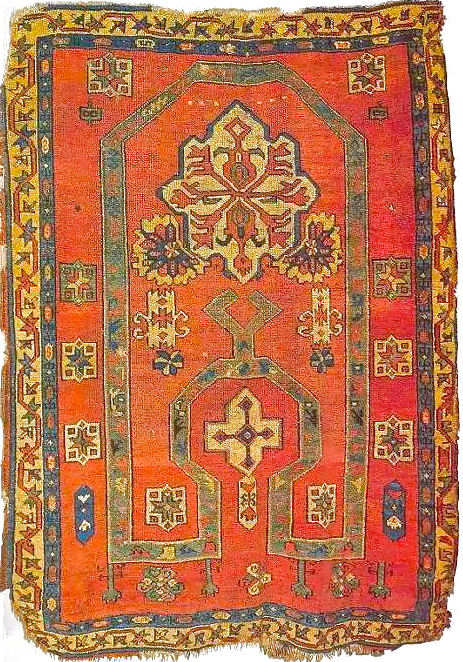
The
so-called “large Holbein” pattern might have been first featured in a
well known Crivelli painting, FIG 54. According to Mills, the origin of
the pattern might be in northwestern Anatolia (7)
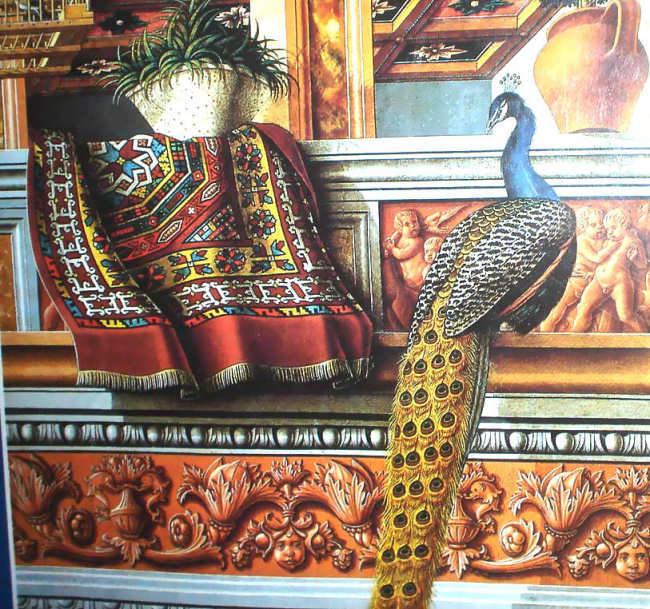
The
rug in Crivelli’s painting looks like a smaller, simplified version of
the roughly contemporaneous extant rug in FIG 55, given as 14th or 15th
century. There is also a clear pattern analogy with the 15-16th century
southern Spanish rug in FIG 56 and several other extant Spanish carpets.
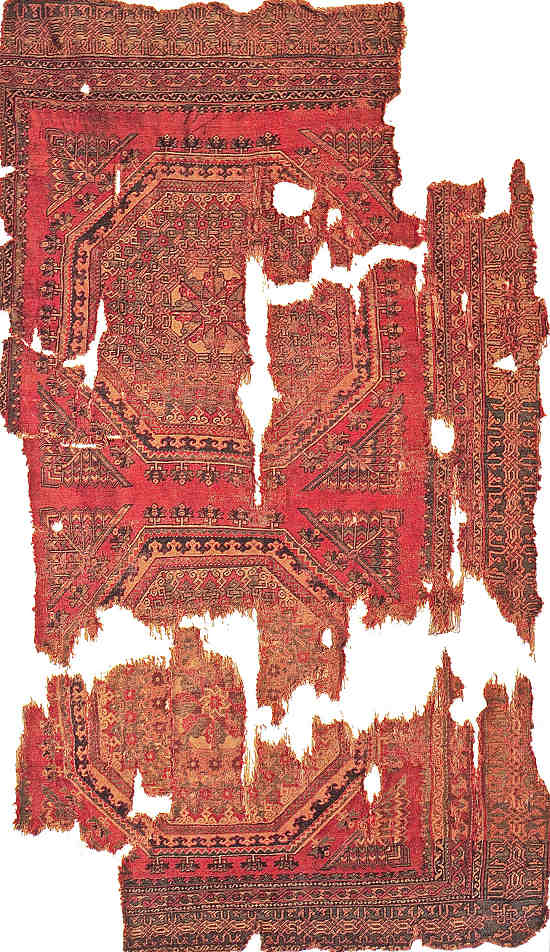
FIG 55
Anatolia. 14th-15th century.
Vakiflar Museum, Teppiche, B. Balkinar & U.Hirsch.
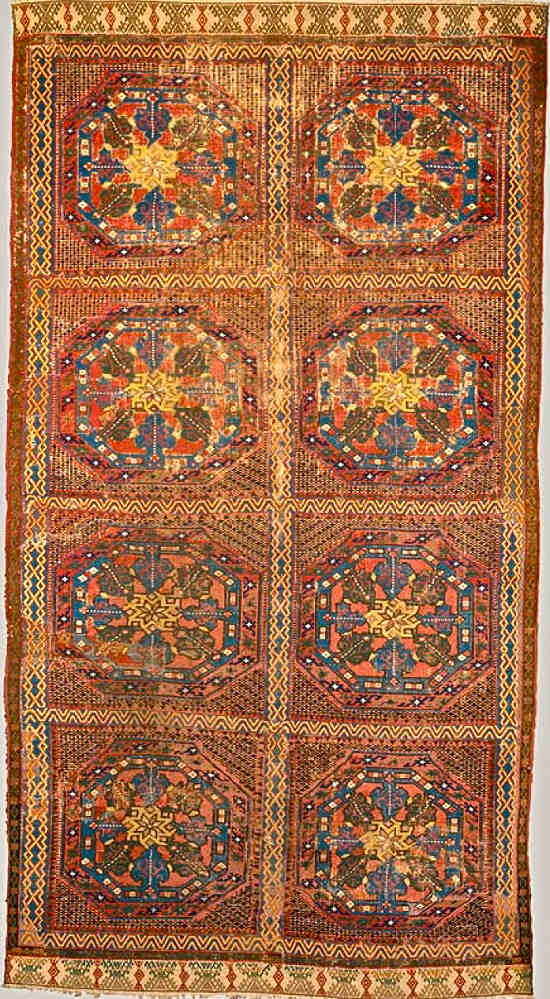
This
leads us to a fourth group of 14th and 15th century rugs, featured in
Spanish paintings and quite possibly woven in southern Spain. It
is well documented that rugs have been produced since the Muslim
conquest in this region, mainly in Alcaraz, Letur, Chinchilla, Cuenca,
Alpujara and Murcia, and that production continued long after the
Christian Reconquista was completed in 1494, and even after a large
part of the Muslim population was forced to emigrate (8).
Several
Moslem writers praised the outstanding quality of Al-Andalus rugs, for
example Ibn Hawkal (10th century) and Al-Idrissi (12th century).
Al-Saqundi (12th century) boasts that these rugs were “exported to all
countries of Orient and Occident”, Cairo being a particularly good
customer. When Leonor de Castilla married the future King Edward I of
England in 1254, the young bride had a main street of London decorated
with her many Spanish rugs (8).
Nearly three centuries later, Henry
VIII’s chancellor, Cardinal Wolsey, still appreciated and collected
Spanish rugs (we will say more about this fanatical ruggie in our next
essay.)
Spanish weavers used a specific knot, shared only with some
Egyptian (coptic?) weavers. Thus, the attributions of extant
Spanish rugs are reasonably certain despite the strong analogy of many
motifs with those of Anatolia.
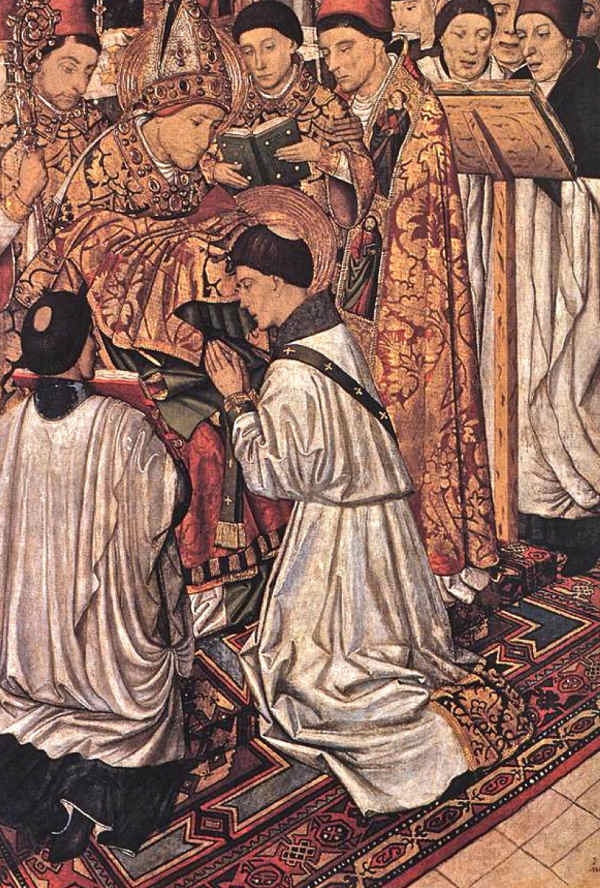
FIG 57
J. Huguet. 1460.
St Vincent ordained by St Valerius
MNAC. Barcelona.

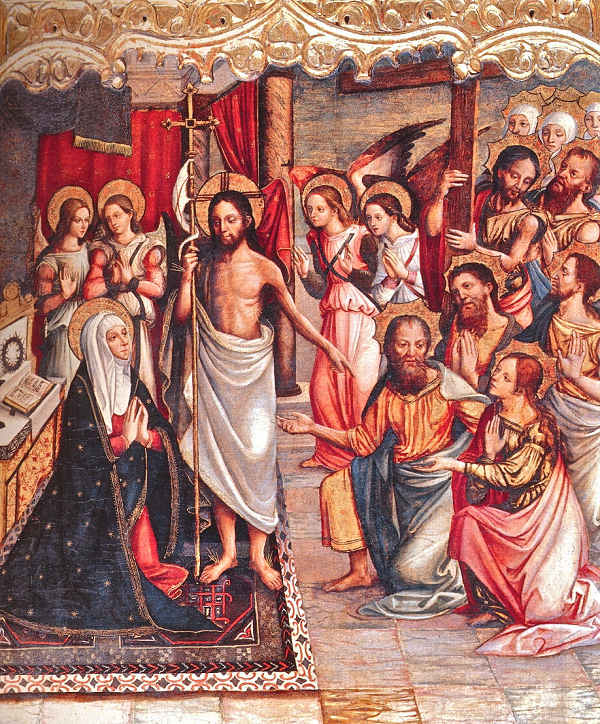
FIG 59
V. Macip. 1480-1500.
Christ resuscitated.
Valencia Cathedral

Note the curvilinear pattern inscribed in hexagons (Renaissance influence?) and the narrow (mudejar?) kufic border of FIG 60.

Many
rugs shown in fourteenth- and fifteenth century paintings feature
unique patterns which fully defeat my occidental urge for classifying
all and everything. Unless I err, most of these orphan carpets do not
even have any extant descendants, poor lonely chaps.
One cannot
exclude that a few rugs were the fruit of the painters imagination, but
most look quite credible, at least to my uneducated eyes. The scholar,
R.A. Mack states that “The Italian elite who commissioned paintings
showing their costly carpets undoubtedly wanted them represented in
details” (9).
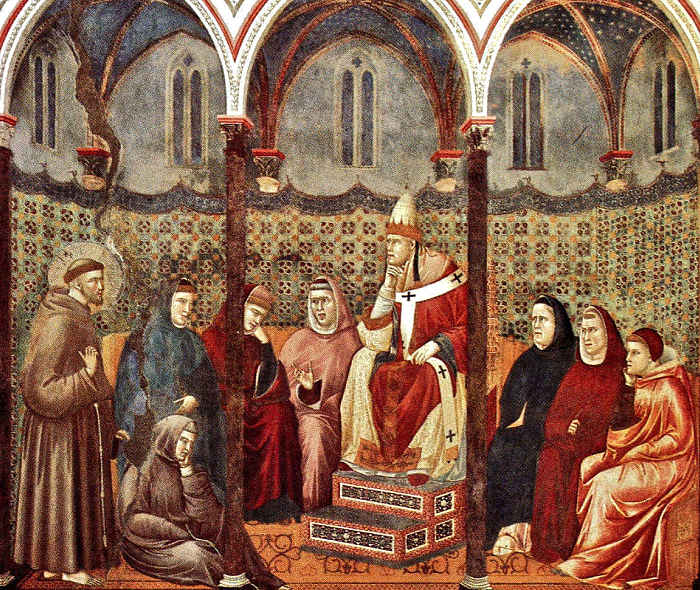
FIG 62
Giotto di Bondone.
1290-1300
St Francis & Honorius III
Detail.
Assisi Basilica.

Quiz
for our many Turkotek rug experts: Is the rug in FIG 63 a kilim?
A rug made sewing together bands of flat weaves like tent bands?
The
field of the “Arnolfini rug” (FIG 64) appears to be woven in parallel
bands featuring the same four motifs on a surmey background. Mills does
not exclude the possibility that it could be a local needlework
(10). The “Sedano” rug (FIG 66) seems to be a variation of the
“large Holbein” pattern.
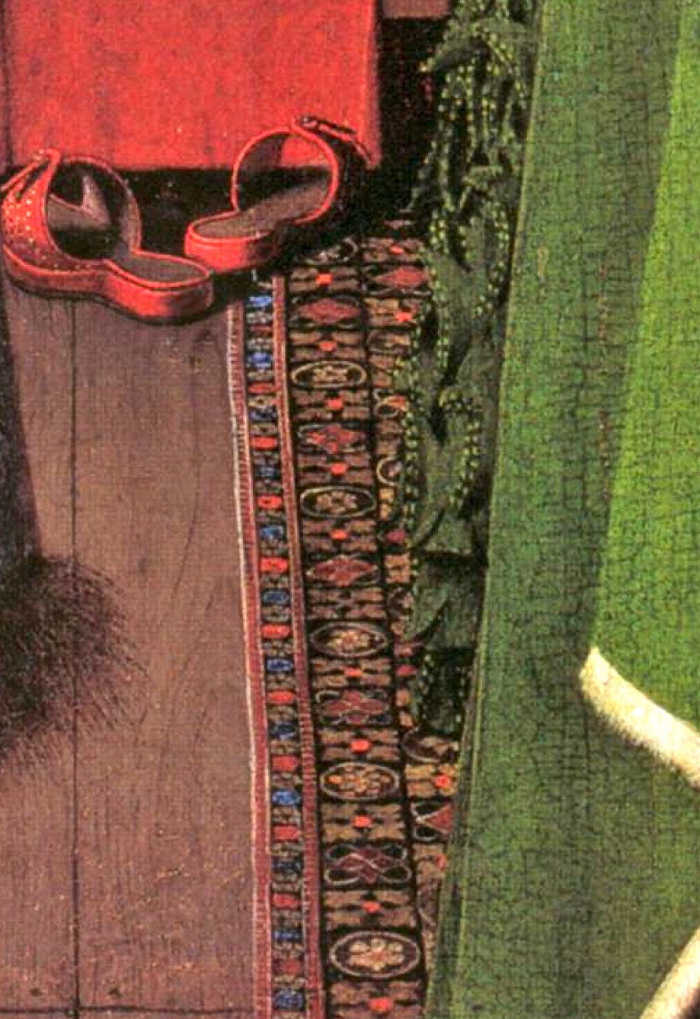
FIG 64
J.
van Eyck.
1434
Portrait of G. Arnolfini and his wife.
Detail
National Gallery. London.
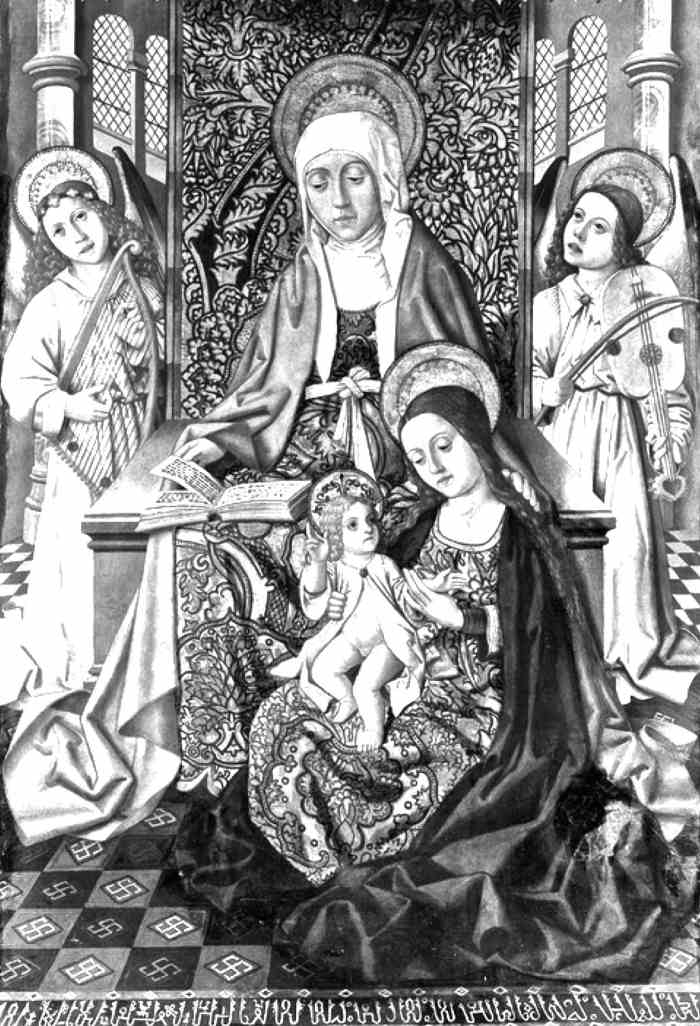
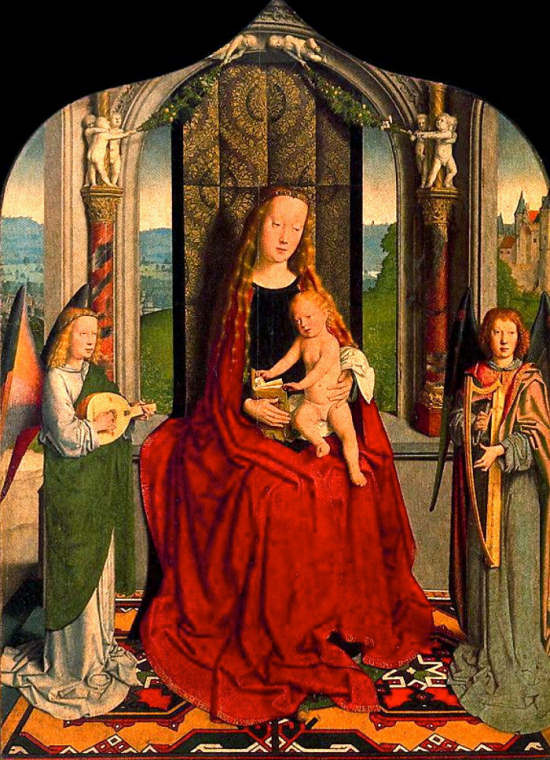
FIG 66
G. David 1490-1495
The Sedano Virgin. Detail.
Louvre. Paris
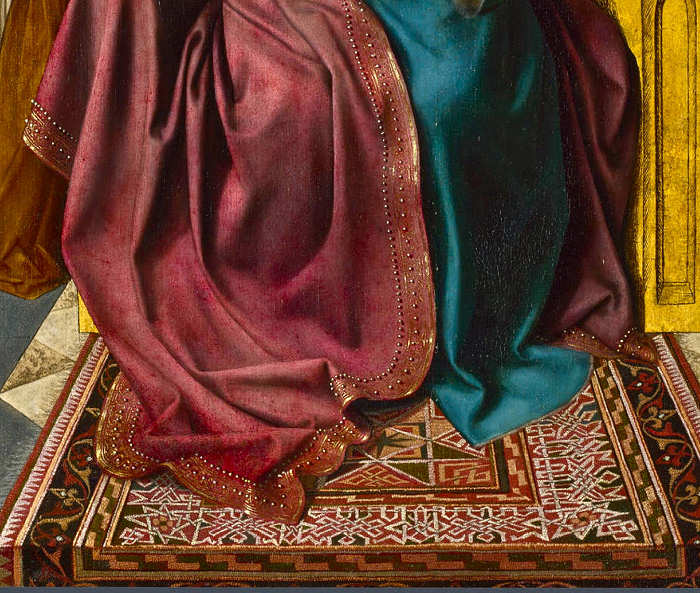
Massy’s
rug (FIG 67) particularly puzzles John Mills (11): “...the elaborate
border of kufic plus endless knot resembles known Turkish borders of
the period, but the exactly contrived solution to the problem of
turning the corners is most unusual, the field design is not a
recognizable one and the curvilinear border accords ill with the
otherwise starkly geometrical border...”
I find the rug in the
French miniature (FIG 68) quite interesting too, with its sober
two-tone indigo field much reminiscent of some earlier Seldjuk rugs
except for the fact that the small repeating motif here is a cross.

My
puzzle-o-meter hits its highest marks with FIG 69, a painting by A. del
Castagno, and with FIG 70, an Il-Khanid (12) miniature from early 14th
century with its field of repeating endless knots and sophisticated
borders, including one kufic.

FIG 69
A. del Castagno. 1445.Virgin & Child.
The Pazzi Madonna
Uffizi. Florence

You
may have noticed the scandalous absence of Memling in this essay.
Indeed this rug-obsessed artist was also very active during the last
quarter of the fifteenth century, but abusing our authority as authors
of this essay, we opted to tell you soon «a tale of two ruggies.
1475-1540» starring Memling and Holbein.
Sources and notes.
(1) Rosamond E. Mack, Bazaar to Piazza, page 78
(2) John Mills, Carpets in Paintings, 1983, pages 11-14.
(3) Giovanni Curatola, in Venise et l’Orient, Tissus et tapis à Venise, page 210. Gallimard. 2006.
(4) Walter. B. Denny, in «Venise et l’Orient», Textiles et tapis d’orient à Venise, page 178. Gallimard. 2006.
(5) Onno Ydema, Carpets in Netherlandish paintings, page 9. (*)
(6) John Mills, carpets in Paintings, 1983, page 20.
(7) John Mills, carpets in Paintings, 1983, page 21.
(8) Alberto Bartolomé Arraiza, Alfombras Españolas, MNAD, page 21-22.
(9) Rosamond E. Mack, Bazaar to Piazza, page 78
(10) John Mills, carpets in Paintings, 1983, pages 11-14.
(11) John Mills, carpets in Paintings, 1983, pages 15-18.
(12) Il-Khanid: Mongol dynasty ruling greater Persia between 1256 and 1335, reporting to the Great Khan.
(*)
Many thanks to Patricia Jansma who suggested buying Onno
Ydema’s outstanding «Carpets and their dating in Netherlandish
paintings»
Part 1: Animal Rugs in Renaissance Paintings
Part 3: A Tale of Three Renaissance Ruggies
Part 4: Rugs in Sixteenth- and Seventeenth Century English Paintings